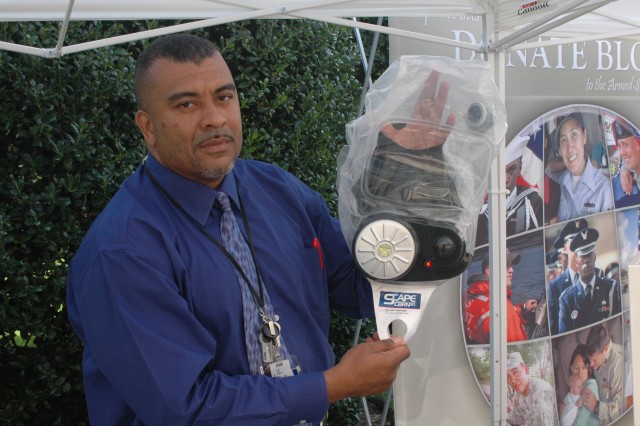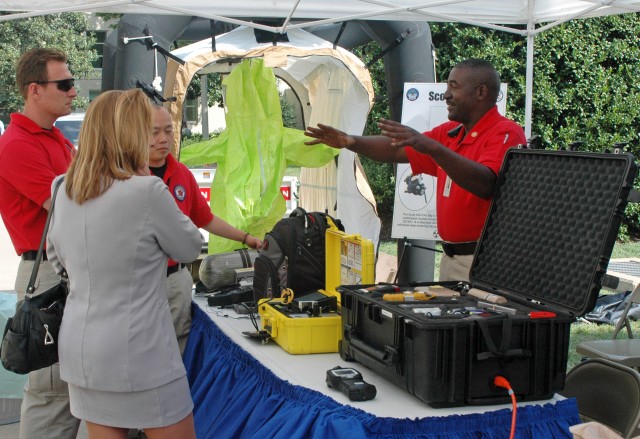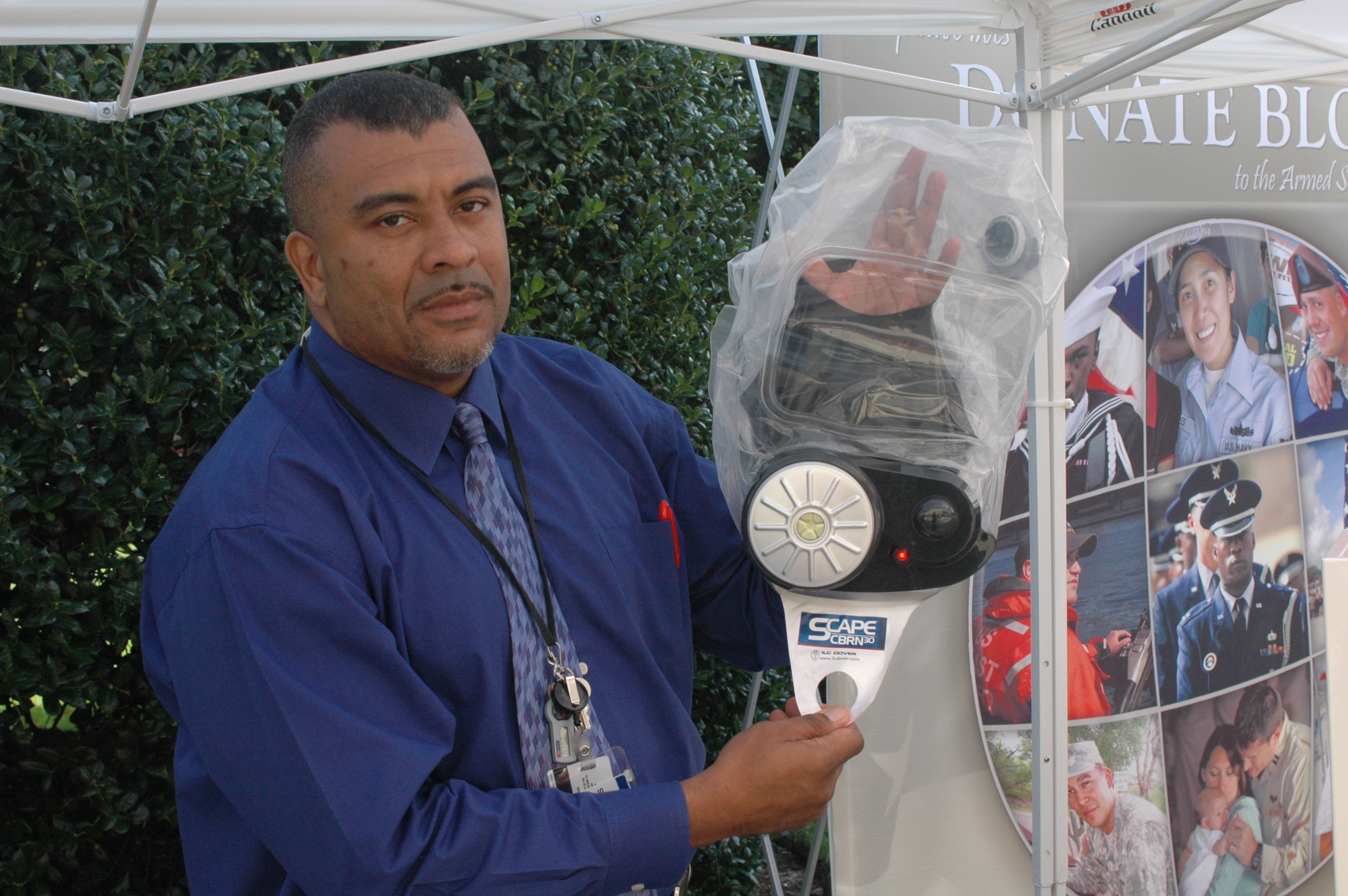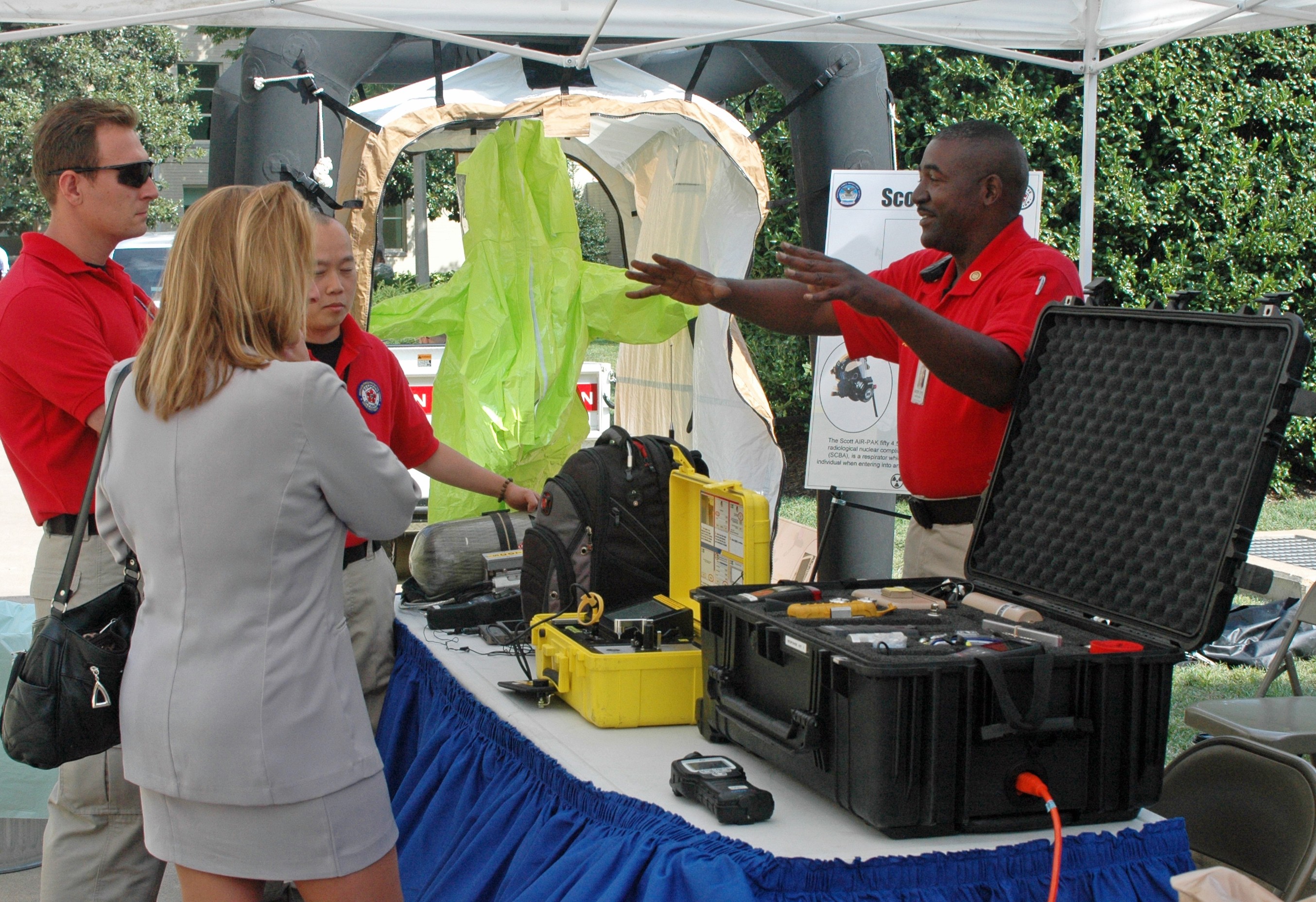WASHINGTON (Army News Service, Sept. 25, 2008) Ready Army -- the Army Emergency Management Program's communication campaign to prepare Soldiers, their families and Army civilians for natural and man-made disasters -- took center stage at the National Preparedness Fair held at the Pentagon Wednesday.
Representatives from the Army Asymmetric Warfare Office -- the Ready Army proponent -- manned one of a dozen or so information booths that showcased what preparedness is all about.
Personnel from Fort Hood, Texas, who prepared to evacuate some 4,000 people in the wake of Hurricane Ike, recently, told their stories of disaster scenarios, via a large TV monitor, bringing to life the harsh realities of a disaster that left 50 people dead and thousands homeless.
A sample Ready Army survival kit - an overflowing basket of "survival" must-haves - sat on the table for visitors to check out and included everything from batteries and a crank-up radio to an iodine-filtration system for purifying water, dust masks and a six-in-one gadget that can charge a cell phone without electricity.
Brochures, pamphlets - even a 16-month calendar listing recommended survival items to purchase over time -- so as not to incur unnecessary, one-time expense -- were available for the taking.
Ready Army provides numerous fact sheets on how to prepare for everything from volcanoes to earthquakes and a modern-day plague, said Patricia Powell, a Ready Army spokeswoman from the Army Asymmetric Warfare Office.
For kids, a special publication called "Ready Army Kids" was offered to help parents teach children about what to do in emergency situations through a word-spy game and a drawing of the inside of someone's home, among other kid-friendly presentations.
The map of rooms is an example from which parents and their children can create their own escape-plan drawings. The Ready Army literature included red arrows indicating where to find emergency supplies, the smoke detector, carbon-monoxide alarm and emergency phone numbers.
Kid-friendly Web sites are listed, too, including www.ready.gov/kids and www.fema.gov/kids, among others.
The day-long fair, sponsored by the Pentagon Force Protection Agency in conjunction with National Emergency-Preparedness Month, also brought together representatives from the PFPA's Emergency Escape Mask Program, Pentagon-based health and safety officials and Department of Defense security and safety personnel.
Health officials provided literature on the physiological effects a disaster can have on the human body. They said being prepared for adverse negative effects, including hypertension and high blood pressure, as examples, could mean the difference between being able to act in an emergency or becoming immobile, as in a bad dream, when a monster's chasing you through a dark alley.
Jason Rea, a PFPA Response Division hazardous-materials technician, introduced visitors to his organization's Level-A suit, which "provides the highest level of protection against everything short of radiation," and the rapid-inflation tent, which can be set up and used as a decontamination center for individuals, who have been exposed to a chemical-biological-radiological agent, within two to three minutes.
Rea assured Pentagon employees that no hazardous fumes could get into their spaces, because "the offices all have positive pressure; air flows out, toward the hallways."
Chemical-biological-radiological detectors, a hazardous-material identification device, air tanks and thermal imagers were among other equipment on display, as were protective masks, which are issued to some 15,000 to 26,000 Pentagon employees, said Kevin Jones, operations chief for the Army Escape Mask program.
"We provide evacuation training and training on how to wear the mask," he said. The old, first-generation mask, which has a mouthpiece and a nose clip, both of which "made people very uncomfortable," are being phased out with what's called ILC Dover, he said. Phase-in of the new mask, which has a motor that filters out contaminants, is to be completed by year's end.
Jones said organizations that would like to be issued masks, can send e-mail to his office at eem@pfpa.mil for consideration. "Send us an e-mail and we'll send a point of contact for your agency." PFPA serves a population of some 65,000 in the National Capital Region, Jones said.
"Preparedness is a personal responsibility," Powell said. "Every step an individual takes [to take care of himself after an emergency situation] enhances the community's ability to respond [to the overall crisis]."
A big part of the Army Ready Campaign is to educate people about how an event can affect them, Powell said. "Most people are complacent."
Powell spoke to Hurricane Katrina survivors after the infamous storm decimated New Orleans, La., several years ago. "Not only had people lost their homes and belongings, they lost their important papers," and, so too, their identities, albeit temporarily.
People need to realize that every official transaction -- from filing an insurance claim to withdrawing money from the bank -- requires identification, certificates, statements of past transactions, and so forth, she said.
For the Army, Ready Army is the key to prepare Soldiers, their families, Army government civilians and contractors, who compose a transient population, for emergency situations, Powell said. Because Soldiers are deployed far from home, because they may not have families close by, they need to have a plan in place for what would happen to family members and pets in an emergency.
Rebecca Marquis, deputy director for the Ready America Campaign, the Department of Homeland Security ad campaign to get all Americans prepared, said the collective focus of fair exhibitors is to educate and prepare people across the country for natural and man-made catastrophes of all kinds.
"We encourage them to have a family plan, know how they'll meet up with loved ones and where they'll go if they have to evacuate an area -- and have enough supplies to sustain themselves until emergency responders can get to them," she said.
Seventy-two hours is the recommended amount of time, but ensuring an adequate supply of food, potable water, needed medicines, baby- and pet-care items and other essentials for longer is better, she said.
"Lots of information is available at the Web site Ready.gov, and we added a link this month that goes to Ready Army, for specific tips for Army families," Marquis said.
Army officials announced the launch of Ready Army last month, in conjunction with the Army Emergency Management Program's annual workshop for installation preparedness in Tampa, Fla.
Previously, Ready Army was a one-year pilot program that tested the effectiveness of emergency notification systems and techniques for the Army at Fort Hood, Texas, and at various installations in Germany, said Powell.
Throughout the year, AEMP personnel work with local emergency-response groups, conduct tests of their response systems and hold annual reviews, said Maj. James Castelli of the Asymmetrical Warfare Office.






Social Sharing